#low code platforms for business developers
Explore tagged Tumblr posts
Text
The Rise of Low-Code/No-Code Platforms
Discover how low-code and no-code platforms are revolutionizing software development. Learn about their benefits, applications across industries, and future projections in this comprehensive guide. Empower your business with agile, cost-effective solution
In recent years, low-code and no-code platforms have emerged as transformative tools in the software development landscape. These platforms enable users to create applications with minimal coding effort, making software development more accessible to non-technical individuals. This article explores the rise of low-code/no-code platforms, their benefits, and their impact on various…
#ai#Application Development#Business Technology#Digital Transformation#Innovation in Tech#Low-Code Platforms#No-Code Development#Software Development#Tech Trends
0 notes
Text
#Custom App Development#business application#Traditional app development#Low Code Development#software development#Benefits Of Low-Code Platforms#FlutterFlow#create a mobile application
0 notes
Text
Exploring the Latest Trends in Software Development
Introduction The software is something like an industry whose development is ever-evolving with new technologies and changing market needs as the drivers. To this end, developers must keep abreast with current trends in their fields of operation to remain competitive and relevant. Read to continue .....
#analysis#science updates#tech news#technology#trends#adobe cloud#business tech#nvidia drive#science#tech trends#Software Solutions#Tags5G technology impact on software#Agile methodologies in software#AI in software development#AR and VR in development#blockchain technology in software#cloud-native development benefits#cybersecurity trends 2024#DevOps and CI/CD tools#emerging technologies in software development#future of software development#IoT and edge computing applications#latest software development trends#low-code development platforms#machine learning for developers#no-code development tools#popular programming languages#quantum computing in software#software development best practices#software development tools
0 notes
Text
Revolutionizing Customer Engagement with Low Code Chatbots from BizMagnets.
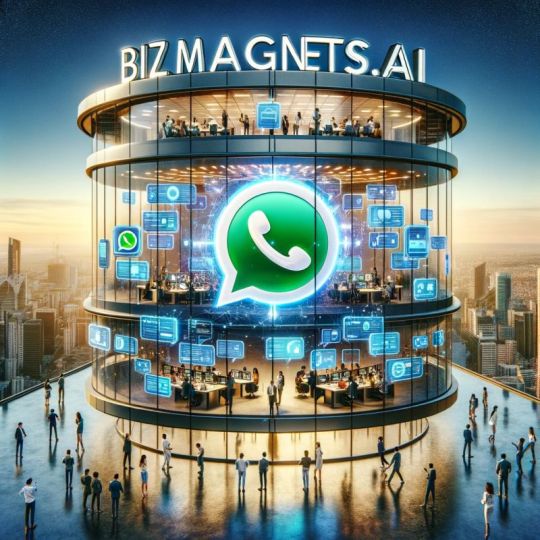
customer engagement is more critical than ever. Businesses are continually seeking innovative ways to connect with their customers, provide instant support, and streamline operations. One solution that is leading the way in revolutionizing customer engagement is the use of low code chatbots, and BizMagnets is at the forefront of this transformation.
But, what if you're not a coding expert? Fear not, because BizMagnets also offers no code chatbot solutions.
In this article, we will explore how low code chatbots from BizMagnets are changing the game and how no code chatbots are making this technology accessible to everyone.
The Rise of Chatbots in Customer Engagement
Chatbots have become an integral part of modern customer engagement strategies. They enable businesses to provide real-time support, answer frequently asked questions, and even facilitate transactions, all within a conversational interface. This technology has the potential to enhance customer experiences while reducing operational costs.
Introducing Low Code Chatbots by BizMagnets
Low code chatbots are a game-changer because they allow businesses to create sophisticated chatbots with minimal coding effort. BizMagnets' low code chatbot platform provides a visual development environment where users can drag and drop components to design chatbot interactions.
Key Benefits of Low Code Chatbots:
Speed and Efficiency: With low code chatbots, businesses can develop and deploy chatbots much faster than traditional coding methods. This means quicker implementation and faster results.
Reduced Dependency on Developers: You don't need a team of developers to create and manage your chatbots. Business analysts and non-technical staff can actively participate in the chatbot development process.
Customization: Low code platforms offer a high degree of customization. You can tailor your chatbot's responses, workflows, and integrations to suit your specific business needs.
Scalability: As your business grows, your chatbots can scale with you. Adding new features and capabilities becomes a straightforward task.

The No Code Revolution
While low code chatbots make development easier, no code chatbots take accessibility to a whole new level. With no code chatbot platforms, you don't need any programming knowledge whatsoever. BizMagnets' no code chatbot solution empowers users to create chatbots through a simple, intuitive interface.
Advantages of No Code Chatbots:
Accessibility: No code chatbots are accessible to everyone in your organization, regardless of their technical background. Anyone can build and manage chatbots.
Rapid Deployment: With no code platforms, you can have a chatbot up and running within minutes. This agility is especially valuable for responding to market changes and customer demands swiftly.
Reduced Costs: Eliminating the need for developers significantly reduces development costs, making chatbot implementation more budget-friendly.
Experimentation: No code platforms encourage experimentation and innovation. You can easily try different chatbot strategies and refine your approach as needed.
BizMagnets: Bridging the Gap
BizMagnets understands that different businesses have different needs. That's why they offer both low code and no code chatbot solutions. Whether you're looking for a solution that provides flexibility and customization through low code development or a straightforward, no code approach for quick chatbot deployment, BizMagnets has you covered.
Realizing the Potential
Businesses that embrace low code and no code chatbots from BizMagnets are positioned to revolutionize their customer engagement. These chatbots can handle inquiries, provide support, automate processes, and enhance user experiences—all while reducing operational complexities and costs.
In conclusion, the revolution in customer engagement is here, and it's being led by low code and no code chatbots from BizMagnets. Whether you're a coding expert or completely non-technical, you can leverage this technology to engage with your customers like never before. The future of customer engagement is accessible, efficient, and powered by BizMagnets.
#nocode#low code/no code#low code development#low code platform#whatsapp business#whatsapp business api#low code#chatgpt integration#chatgpt 4
0 notes
Text
What benefits of using AI with low-code/no-code platforms do you see?
[ ] I haven’t used AI with low-code/no-code platforms
[ ] AI helps with initial project generation for new products
[ ] AI allows for faster generation of data models, user interfaces, business rules, or other components
[ ] AI acts as a subject matter expert to help generate proper business functionality
[ ] AI reduces requirements for training and knowledge from developers
[ ] AI increases velocity when building integrations with other systems
[ ] AI improves productivity for developers and reduces the workforce needed
[ ] I haven’t observed any benefits from using AI with low-code/no-code platforms
[X] Other, please specify:
Good AI could tell stakeholders to avoid no-code platforms
19 notes
·
View notes
Text
Future of LLMs (or, "AI", as it is improperly called)
Posted a thread on bluesky and wanted to share it and expand on it here. I'm tangentially connected to the industry as someone who has worked in game dev, but I know people who work at more enterprise focused companies like Microsoft, Oracle, etc. I'm a developer who is highly AI-critical, but I'm also aware of where it stands in the tech world and thus I think I can share my perspective. I am by no means an expert, mind you, so take it all with a grain of salt, but I think that since so many creatives and artists are on this platform, it would be of interest here. Or maybe I'm just rambling, idk.
LLM art models ("AI art") will eventually crash and burn. Even if they win their legal battles (which if they do win, it will only be at great cost), AI art is a bad word almost universally. Even more than that, the business model hemmoraghes money. Every time someone generates art, the company loses money -- it's a very high energy process, and there's simply no way to monetize it without charging like a thousand dollars per generation. It's environmentally awful, but it's also expensive, and the sheer cost will mean they won't last without somehow bringing energy costs down. Maybe this could be doable if they weren't also being sued from every angle, but they just don't have infinite money.
Companies that are investing in "ai research" to find a use for LLMs in their company will, after years of research, come up with nothing. They will blame their devs and lay them off. The devs, worth noting, aren't necessarily to blame. I know an AI developer at meta (LLM, really, because again AI is not real), and the morale of that team is at an all time low. Their entire job is explaining patiently to product managers that no, what you're asking for isn't possible, nothing you want me to make can exist, we do not need to pivot to LLMs. The product managers tell them to try anyway. They write an LLM. It is unable to do what was asked for. "Hm let's try again" the product manager says. This cannot go on forever, not even for Meta. Worst part is, the dev who was more or less trying to fight against this will get the blame, while the product manager moves on to the next thing. Think like how NFTs suddenly disappeared, but then every company moved to AI. It will be annoying and people will lose jobs, but not the people responsible.
ChatGPT will probably go away as something public facing as the OpenAI foundation continues to be mismanaged. However, while ChatGPT as something people use to like, write scripts and stuff, will become less frequent as the public facing chatGPT becomes unmaintainable, internal chatGPT based LLMs will continue to exist.
This is the only sort of LLM that actually has any real practical use case. Basically, companies like Oracle, Microsoft, Meta etc license an AI company's model, usually ChatGPT.They are given more or less a version of ChatGPT they can then customize and train on their own internal data. These internal LLMs are then used by developers and others to assist with work. Not in the "write this for me" kind of way but in the "Find me this data" kind of way, or asking it how a piece of code works. "How does X software that Oracle makes do Y function, take me to that function" and things like that. Also asking it to write SQL queries and RegExes. Everyone I talk to who uses these intrernal LLMs talks about how that's like, the biggest thign they ask it to do, lol.
This still has some ethical problems. It's bad for the enivronment, but it's not being done in some datacenter in god knows where and vampiring off of a power grid -- it's running on the existing servers of these companies. Their power costs will go up, contributing to global warming, but it's profitable and actually useful, so companies won't care and only do token things like carbon credits or whatever. Still, it will be less of an impact than now, so there's something. As for training on internal data, I personally don't find this unethical, not in the same way as training off of external data. Training a language model to understand a C++ project and then asking it for help with that project is not quite the same thing as asking a bot that has scanned all of GitHub against the consent of developers and asking it to write an entire project for me, you know? It will still sometimes hallucinate and give bad results, but nowhere near as badly as the massive, public bots do since it's so specialized.
The only one I'm actually unsure and worried about is voice acting models, aka AI voices. It gets far less pushback than AI art (it should get more, but it's not as caustic to a brand as AI art is. I have seen people willing to overlook an AI voice in a youtube video, but will have negative feelings on AI art), as the public is less educated on voice acting as a profession. This has all the same ethical problems that AI art has, but I do not know if it has the same legal problems. It seems legally unclear who owns a voice when they voice act for a company; obviously, if a third party trains on your voice from a product you worked on, that company can sue them, but can you directly? If you own the work, then yes, you definitely can, but if you did a role for Disney and Disney then trains off of that... this is morally horrible, but legally, without stricter laws and contracts, they can get away with it.
In short, AI art does not make money outside of venture capital so it will not last forever. ChatGPT's main income source is selling specialized LLMs to companies, so the public facing ChatGPT is mostly like, a showcase product. As OpenAI the company continues to deathspiral, I see the company shutting down, and new companies (with some of the same people) popping up and pivoting to exclusively catering to enterprises as an enterprise solution. LLM models will become like, idk, SQL servers or whatever. Something the general public doesn't interact with directly but is everywhere in the industry. This will still have environmental implications, but LLMs are actually good at this, and the data theft problem disappears in most cases.
Again, this is just my general feeling, based on things I've heard from people in enterprise software or working on LLMs (often not because they signed up for it, but because the company is pivoting to it so i guess I write shitty LLMs now). I think artists will eventually be safe from AI but only after immense damages, I think writers will be similarly safe, but I'm worried for voice acting.
8 notes
·
View notes
Text
Best Payment Gateway In India– Quick Pay

In today's digital era, businesses of all sizes need a reliable, secure, and efficient payment gateway to process online transactions. Whether you're running an e-commerce store, a subscription-based service, or a brick-and-mortar shop expanding to digital payments, choosing the right payment gateway can significantly impact your success. Among the many options available, Quick Pay has emerged as one of the best payment gateways in the industry.
This article explores the features, benefits, security measures, and why Quick Pay is the preferred choice for businesses worldwide.
What is Quick Pay?
Quick Pay is a cutting-edge payment gateway solution that facilitates seamless online transactions between merchants and customers. It offers a secure and user-friendly interface, allowing businesses to accept payments via credit cards, debit cards, mobile wallets, and bank transfers. Quick Pay supports multiple currencies and integrates with various e-commerce platforms, making it a versatile choice for businesses operating locally and globally.
Key Features of Quick Pay
1. Multi-Channel Payment Support
One of the standout features of Quick Pay is its ability to support multiple payment channels, including:
Credit and debit card processing (Visa, Mastercard, American Express, etc.)
Mobile wallets (Apple Pay, Google Pay, PayPal, etc.)
Bank transfers and direct debit
QR code payments
Buy Now, Pay Later (BNPL) services
This flexibility ensures that businesses can cater to customers' diverse payment preferences, thereby enhancing the checkout experience and improving sales conversion rates.
2. Seamless Integration
Quick Pay offers seamless integration with major e-commerce platforms like Shopify, WooCommerce, Magento, and BigCommerce. Additionally, it provides APIs and plugins that allow businesses to customize payment processing according to their specific needs. Developers can easily integrate Quick Pay into their websites and mobile applications without extensive coding knowledge.
3. High-Level Security & Fraud Prevention
Security is a top priority for any payment gateway, and Quick Pay excels in this area with:
PCI DSS compliance (Payment Card Industry Data Security Standard)
Advanced encryption technology to protect sensitive data
AI-driven fraud detection and prevention mechanisms
3D Secure authentication for an extra layer of security
By implementing these security measures, Quick Pay minimizes fraudulent transactions and enhances customer trust.
4. Fast and Reliable Transactions
Speed and reliability are crucial in online payments. Quick Pay ensures that transactions are processed swiftly with minimal downtime. It supports instant payment processing, reducing wait times for merchants and customers alike. Businesses can also benefit from automated settlement features that streamline fund transfers to their bank accounts.
5. Competitive Pricing & Transparent Fees
Unlike many payment gateways that have hidden charges, Quick Pay provides transparent pricing models. It offers:
No setup fees
Low transaction fees with volume-based discounts
No hidden maintenance or withdrawal charges
Custom pricing plans for high-volume merchants
This cost-effective approach makes Quick Pay a preferred choice for startups and large enterprises alike.
6. Recurring Payments & Subscription Billing
For businesses offering subscription-based services, Quick Pay provides a robust recurring payment system. It automates billing cycles, reducing manual efforts while ensuring timely payments. Customers can set up autopay, making it convenient for them and improving customer retention rates for businesses.
7. Multi-Currency & Global Payment Support
In an increasingly globalized economy, accepting international payments is vital. Quick Pay supports transactions in multiple currencies and offers dynamic currency conversion. This allows businesses to cater to international customers without dealing with complex exchange rate issues.
Benefits of Using Quick Pay
1. Enhanced Customer Experience
Quick Pay ensures a smooth checkout experience by providing multiple payment options and a user-friendly interface. Faster payment processing reduces cart abandonment and boosts customer satisfaction.
2. Improved Business Efficiency
With automated invoicing, seamless integration, and real-time transaction tracking, businesses can streamline their payment operations, saving time and resources.
3. Higher Security & Reduced Fraud Risk
With its state-of-the-art security measures, Quick Pay minimizes risks associated with fraud and data breaches. This enhances business credibility and customer trust.
4. Increased Sales & Revenue
Supporting multiple payment options and international transactions helps businesses tap into a broader customer base, leading to higher sales and revenue growth.
How to Set Up Quick Pay for Your Business?
Setting up Quick Pay is a straightforward process:
Sign Up – Visit the Quick Pay website and create an account.
Verify Business Details – Submit the required business documents for verification.
Integrate Quick Pay – Use APIs, plugins, or custom scripts to integrate Quick Pay into your website or app.
Configure Payment Options – Select the preferred payment methods you want to offer customers.
Go Live – Once approved, start accepting payments seamlessly.
Why Quick Pay Stands Out Among Competitors
While several payment gateways exist, Quick Pay differentiates itself with:
Superior security measures compared to standard gateways.
Faster payouts than many competitors, ensuring businesses receive funds quicker.
Customer-friendly interface making it easier for both merchants and users.
Scalability, accommodating businesses from small startups to large enterprises.
Conclusion
Quick Pay is undoubtedly one of the best payment gateway in India available today. Its blend of security, efficiency, affordability, and ease of use makes it an ideal choice for businesses across various industries. Whether you run an e-commerce store, a SaaS business, or a global enterprise, Quick Pay ensures smooth, secure, and hassle-free payment processing.
By choosing Quick Pay, businesses can enhance customer experience, reduce fraud risks, and boost revenue. With seamless integration, multi-currency support, and advanced features, Quick Pay is the go-to payment gateway for modern businesses looking for a reliable and future-proof payment solution.
Are you ready to streamline your payments and take your business to the next level? Sign up for Quick Pay today!
2 notes
·
View notes
Text
The Future of ERP Integrations: How Low-Code and No-Code Platforms Are Changing the Game
Enterprise Resource Planning (ERP) systems’ primary goal has been to enhance business operations through streamlining critical processes such as finance or supply chain management. However, to be honest, the integration of the ERPs with other tools has not always been an easy task. It was really a nightmare for companies to integrate ERPs with the other tools. Time-consuming development cycles, huge IT costs, and some complex coding requirements totally turned ERP integrations into a mess for businesses.
But, here are low-code and no-code platforms like Odoo ERP that are quite the game-changers in ERP integrations. These contemporary remedies have made it much easier, faster, and cheaper to connect ERPs with other business applications. Let me explain to you how they are altering the landscape.

Breaking Down the Buzz: What Are Low-Code and No-Code Platforms?
Low-code platforms enable users to develop applications by designing visually with less code. They include visual design immediate productivity capabilities that promise to fast-track work for a broad spectrum of users in the organization.
No-code platforms take the automation level a little further allowing even average users like IT, ERP, engineers, business analysts, and business owners to create their systems the way they want without having to write a single line of code, and thus they can focus on tasks that matter.
By doing this, businesses just simply change their budget from standard, long, and costly ERP integrations to the cloud.
How Low-Code & No-Code Are Transforming ERP Integrations
Speed Like Never Before - Traditional ERP integrations used to be a time-consuming process and often took weeks, sometimes even months. The use of low-code/no-code tools has become revolutionary and businesses can now develop integrations in just a few days or hours. At the same time, pre-built Connectors and Templates, and automation tools certainly make the life of developers easier.
Reduced IT Dependency - In the past, ERP integrations necessitated the participation of IT teams or even external developers. Over time, the implementation of the low code/no code approach has increasingly led to newcomers getting involved. For instance, the business user can take up the role of the IT team, and as a result, the bottleneck is removed, and the tech teams do more strategic tasks.
Cost Savings Galore - The cost of hiring developers for custom ERP integrations can be hefty. On the other hand, Low-code/no-code solutions indeed offer the benefit of not needing much real developer input. As a result, such systems can be set up and maintained by non-technical employees alone.
Flexibility & Scalability - Companies are getting innovative and growing while software needs are also changing. With the help of low-code/no-code technologies, organizations can accomplish this by simply changing the integration on the go (so to speak). This way, there is no need to reinvent software every time there is a need for change.
Enforced Security & Compliance - No-code/low-code transformational strategies that are inherently secured and compliant mean that ERP integrations will be fulfilled with the required regulations hassle-free for IT teams.
Who’s Leading the Low-Code/No-Code Revolution?
Several players are shaking up the ERP integration landscape. Platforms like Odoo, Zapier, Mendix, OutSystems, and Microsoft Power Automate are leading the charge, making ERP integrations accessible to businesses of all sizes.
Is This the End of Traditional ERP Integrations?
No, it's not. Traditional coding is still very much a necessity for complex and highly customized integrations. However, low-code and no-code platforms are help in most cases to save time, money, and energy.
Odoo: A Top Low-Code ERP
Odoo is one of the best low-code ERP platforms, offering flexibility, automation, and easy customization. With its modular design and drag-and-drop tools, businesses can streamline operations without deep coding expertise.
Final Thoughts: The Future is Here
The days of painful, drawn-out ERP integrations are fading. Low-code and no-code platforms like Odoo are making ERP connectivity easier than ever, allowing businesses to focus on growth rather than technical roadblocks. If your company hasn’t explored these tools yet, now’s the time to jump in!
The future of ERP integrations is fast, flexible, and code-free—are you ready for the Odoo upgrade?
Read more: Click Here
3 notes
·
View notes
Text
Website Development Trends to Watch in 2025 🌐🚀

As technology evolves, so do website development trends. In 2025, businesses must adapt to faster, smarter, and more user-friendly web experiences.
Here are the top trends shaping web development in 2025—and how they impact businesses and developers.
🚀 Top Web Development Trends in 2025
1️⃣ AI-Powered Web Development 🤖
AI and machine learning are revolutionizing how websites are built. Expect: ✔ AI-driven design tools for faster site creation ✔ Automated customer support with chatbots ✔ Personalized user experiences powered by AI
💡 Example: AI tools like Wix ADI can now design entire websites based on user preferences!
2️⃣ Web 3.0 & Decentralized Websites 🌐
The rise of blockchain and decentralized networks is changing web infrastructure. Key developments include: ✔ Decentralized hosting for greater security ✔ Blockchain integration for identity verification ✔ Smart contracts for seamless transactions
3️⃣ Progressive Web Apps (PWAs) 📱
PWAs are bridging the gap between websites and mobile apps, offering: ✔ Fast loading speeds & offline capabilities ✔ App-like experience on browsers ✔ Lower development costs compared to native apps
💡 Big brands like Twitter and Starbucks use PWAs for improved user engagement!
4️⃣ Voice Search & Conversational UI 🎙️
As voice assistants grow, websites must optimize for voice search SEO. Expect: ✔ Conversational keywords & structured data ✔ Voice-enabled navigation for hands-free browsing ✔ AI-powered chatbots for instant responses
5️⃣ Dark Mode & Adaptive UI 🎨
More websites will offer dark mode options to: ✔ Reduce eye strain & improve accessibility ✔ Save battery life on mobile devices ✔ Offer a sleek, modern design
6️⃣ No-Code & Low-Code Development ⚡
More businesses are embracing drag-and-drop builders for faster development. Key platforms: ✔ Webflow, Bubble, and Wix for no-code ✔ Low-code solutions for faster backend integrations ✔ Faster website launches without deep coding skills
📉 What’s Fading in 2025?
🚫 Overcomplicated UI/UX – Simplicity and clarity are winning. 🚫 Static Websites – Interactive and AI-driven content dominates. 🚫 Traditional SEO Strategies – Voice and AI-powered search optimization take over.
Final Thoughts: Stay Ahead in 2025
The future of website development revolves around AI, speed, security, and user experience. Businesses that embrace these trends will stay competitive and enhance customer engagement.
🌟 Which trend are you most excited about? Let us know in the comments!
#seo#social media marketing#digital marketing company#digital marketing services#seo services#digital marketing#emailmarketing#ppc
2 notes
·
View notes
Text
We are a top IT consultancy company and no code and low code development service providers. By designing, building and automating, our aim is to turn your ideas into reality. No-code and low-code development creates no-code SaaS solutions, automate workflows, streamline app development and empower businesses to build apps without extensive and manual coding. Businesses can automate workflows and rapidly develop apps by leveraging no-code and low-code development platforms. Without traditional programming, digital strategies are transformed, processes are streamlined and no-code SaaS development is driven.
#low code development#no code development#web developing company#software#information technology#web development
4 notes
·
View notes
Text
Technology Bias - Fuchs' 6 Dimensions of Critical Theory
After reading Rethinking Cyberfeminisms by J. Daniels, Automating Inequality (Introduction) by V. Eubanks, and watching Nicole Brown: Race and Technology, these are some of the questions I've come up with using Christian Fuchs' Six Dimensions of Critical Theory frameworks:
1: In Automating Inequality, Eubanks argued that technology can put many underrepresented groups/communities at a disadvantage. How are biases presented within these automated systems, and what can we do to prevent biases?
Some bias automated systems presented today that causes harm to marginalized communities can include but are not limited to, welfare programs, criminal justice, and hiring procedurals. These systems show signs of biases and inequality through algorithms and automated decision-making code that tends to target low-income individuals or people of color. To be more specific, welfare programs often deny or push back grants/benefits to those who needs them the most simply because of a system glitch. On the other hand, automated decision-making in hiring algorithms may rule out candidates from underserved communities, resulting in an economic opportunities limitation. In order to prevent or minimize these biases from continuing, several steps can be taken to increase system fairnesses. Firstly, governments and companies should increase public transparency and accountability by disclosing how their automated algorithms function as well as being accountable for their bias actions or results. Secondly, governments and businesses should increase human intervention during decision making instead of depending solely on automated decision-makers. Thirdly, government and companies should include diverse perspectives from different backgrounds when developing automated systems to reduce bias.
2: In Rethinking Cyberfeminisms, Daniels questions the idea that the internet is a safe space for empowering women. How does this belief conceal the ongoing gender disproportionate in the digital world?
Digital media platforms are often advertised as a safe space for all individuals to express their thoughts and even gender identity. However, even in today world, one of the biggest concerns that continue to occur is online harassment and cyber bullying. This issue often target women, women of color, and even those in the LGBTQ+ community. One of the reasons behind this issue ties back to gender inequality in the tech industry today. Most tech companies are dominated by men regardless of advocation for women in techs. Due to the lack of gender diversity in technological development, most algorithms and AI development tools are often designed in disregard to women's needs. As a result, we often see AI systems such as voice assistant (Siri) defaulting to submissive female voices, or facial recognition function performing poorly on people of color.
3. In Race and Technology introduced by Nicole Brown, the assistant professor discussed racism in the tech world as well as the political economy. How do money-driven part of business causes racial and gender inequality to persist?
It is uncommon to witness deceptive business practices in today's world regardless of how big a company may be or the many regulations that has been passed. This tie back to the lack of gender diversity in tech companies, which results in poor technological development. For example, the majority of tech executives are made up of white males, therefore, judgements and perspectives of marginalized groups are often neglected. As a result, bias in products such as surveillance cameras sold to law enforcement agencies has a higher percentage of misidentification between Black and Brown people which leads to wrongful arrest and over-policing. Overall, gender and racial inequality continue to persist today as greed often overtake ethics, causing businessmen to commit wrongful acts although they didn't mean any ill intention.
4. What are some ways people can practice to fight for equality, inclusivity, and a fairer system within the digital world?
To fight for equality and inclusivity is a work of a nation, not just an individual alone. This process requires a great amount of policy reforms as well as advocacy and activisms of collective groups. In order to minimize bias in technology, we can demand changes by speaking the truth and exposing unfairness in technology products. Furthermore, companies should place a higher priority for policy reforms and be held accountable for any bias decision-making. Additionally, to ensure that the future of technology is just and fair, it's crucial that we promote and encourage women and people of color to pursue careers in tech. Finally, we as users of digital products should take actions by educating ourselves on the important of utilizing technologies responsibly and how to recognize biases in the digital space.
Brown, N. (n.d.). Race and Technology. Youtube. https://www.youtube.com/watch?v=d8uiAjigKy8
Daniels, J. (2009). Rethinking Cyberfeminism(s): Race, Gender, and Embodiment. WSQ: Women's Studies Quarterly 37(1), 101-124. https://dx.doi.org/10.1353/wsq.0.0158.
Eubanks, V. (n.d.). Automating Inequality. uCoz. https://tetrazolelover.at.ua/virginia_eubanks-automating_inequality-how_high-te.pdf
4 notes
·
View notes
Text
FlutterFlow: The Right Platform to Embark Your Startup Journey

In the cut-throat competitive landscape of businesses, time to market, technology used, and profits generated are the cornerstones of defining success. The capability to implement advanced technology to innovate your business application and execute it successfully gives you a competitive edge. Traditional app development, with its daunting coding requirements and long timelines, often poses challenges for startups with an extended time to market.
Enters, low-code platforms that offer a simple solution to accelerate development without compromising on development quality. One of such platforms gaining popularity is, FlutterFlow.
Let’s explore why FlutterFlow is loved by so many startups and what it brings to the table. Before we get into the nitty-gritty of FlutterFlow, let’s dig in a little deeper to understand low-code development.
What Is Low Code Development?
Low code development refers to software development environments that let developers build applications through graphical user interfaces rather than traditional codes. The platforms reduce the amount of manual coding, which results in faster development lifecycles and easier iterations.
Benefits Of Low-Code Platforms
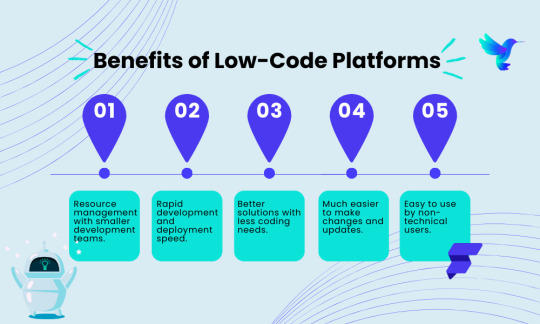
Rapid development and deployment speed.
Resource management with smaller development teams.
Better solutions with less coding needs
Easy to use by non-technical users, making it easier for them to contribute to the app development process.
Much easier to make changes and updates.
Thus with the ease and accessibility to even non-technical users, Low Code development is helping startups create professional applications on a budget. Some of the popular low-code platforms are Appian, Creatio, Outsystems, FlutterFlow, etc.
FlutterFlow gets a lead over others as it is taking low code development to new heights. Let’s now explore what makes FlutterFlow a perfect platform for your startup.
What is FlutterFlow?
FlutterFlow is built on Google’s Flutter framework, designed for developing cross-platform applications for Android, iOS, and the web. It offers a visual design interface, allowing users to plan app layouts effortlessly through simple drag-and-drop capability. FlutterFlow helps real-time collaboration, making it best for teams working together on a development project.
With an easy-to-use interface, no technical skills, and a strong framework to back it, FlutterFlow has been gaining popularity since it was conceived. Whether you are a startup or a small-scale business, if you want to create a mobile application that resonates with your audience, then, choose the FlutterFlow platform and let things flow.
Why FlutterFlow Is Perfect for Startups?
FlutterFlow is taking low code development to new heights by offering a visual development environment where users can build the solutions they want without compromising on app feature quality.
FlutterFlow basically incorporates and promotes best practices for software development. The platform streamlines complex IDE tasks into an intuitive UI, making developer interactions easier. To use the platform one needs basic training, thus even non-developers get into the basics of core app development concepts.
FlutterFlow entered the market with a vision to go from low code development to visual development. Here’s how the team is planning to achieve their goals:
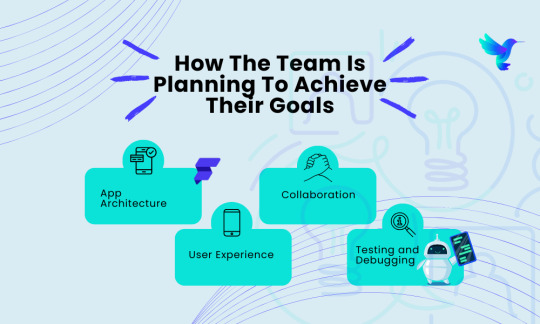
App Architecture: The codes generated using FlutterFlow meet the standards set by Flutter and Dart. They abide by the standard app market, thus helping users with a credible app development solution.
Testing and Debugging: The developers can simply test and debug the applications by running, testing, and resolving issues. This allows startups to enter the market with a flawless and highly rewarding application.
Collaboration: With modular development, smart version controls, and comprehensive access management, users can collaborate easily for better results.
User Experience: With an easy-to-explore interface, edit on clicks, ensure consistency, incorporate AI where possible, and users can switch between code and GUI.
FlutterFlow offers startups an environment where they can cross-operate, collaborate, and discuss their problems. The platform is conceived to make development easier, more convenient, and accessible for non-tech people also, who can easily make their contribution to the web now!
Some of the other advantages of the platform are:
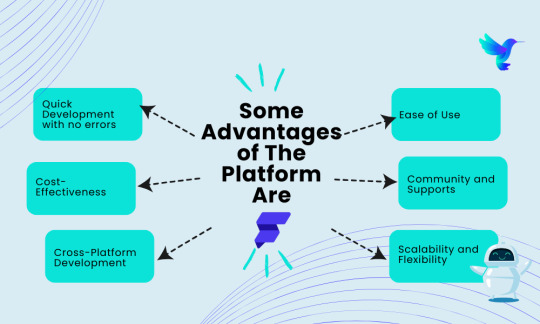
1. Quick Development With No Errors
The cheat code to making the best of your business is, to enter the market ASAP.
One of the most significant benefits of FlutterFlow is the speed at which the projects may develop. The platform’s visual interface and pre-built elements allow for speedy prototyping and development. Startups can fast-build minimum viable products (MVPs) to check thoughts in the marketplace without making a heavy investment in development sources.
Thus, you can create a product faster, take it to the market, and get feedback easily. We understand not every product works well on the first go, but with FlutterFlow you get the ease of making iterations and offering your audience a solution they’d appreciate.
2. Cost-Effectiveness
Most startups run on budget constraints. FlutterFlow helps reduce investing in large teams of seasoned developers. The platform’s drag-and-drop capability and pre-built templates lessen the quantity of custom code required, which translates to lower support and maintenance fees. A developer with lesser experience and understanding of the development languages can also, easily create an app here making it easier for you to invest your funds in other business verticals too.
3. Cross-Platform Development
FlutterFlow’s foundation lies at the Flutter framework which guarantees that applications are cross-platform by default. Thus by picking FlutterFlow startups can create and deploy applications to iOS, Android, and net platforms simultaneously. This cross-platform functionality is crucial for startups looking to maximize their target audience and digital presence without incurring the expenses and complexities of keeping separate codebases for specific platforms.
4. Ease Of Use
FlutterFlow is designed to be user-friendly, making it accessible to both skilled app developers and those with limited coding exposure. This democratization of app development means that non-technical founders and team members can contribute to the development procedure. FlutterFlow also gives tremendous documentation and tutorials, further decreasing the barrier to entry.
Because it is easy to use, the startup founders can make changes to the product as they want.
5. Scalability And Flexibility
Despite being a low-code platform, FlutterFlow gives massive flexibility. Users can add custom code to increase the functionality of their programs, making sure that they are now not confined with the aid of the platform’s built-in features. FlutterFlow additionally integrates seamlessly with backend services like Firebase and Supabase, bearing in mind robust and scalable backend solutions.
6. Community And Support
Being part of the Flutter ecosystem, FlutterFlow advantages from an active and supportive community. This network affords a wealth of assets, tutorials, and discussions that could assist startups conquer challenges and make the most of the platform. Additionally, FlutterFlow is continually evolving, with new capabilities and improvements being brought often based on user comments.
New users can always connect with the community for any assistance and customization thus creating a growth-oriented and learning ecosystem.
These are some of the most popular reasons why FlutterFlow is one of the most prominent low-code platforms for startups. So, if you are aiming to start your entrepreneurial journey and aren’t sure how to start without investing much in development, FlutterFlow is your trusted development partner.
Addressing Common Concerns of Using FlutterFlow
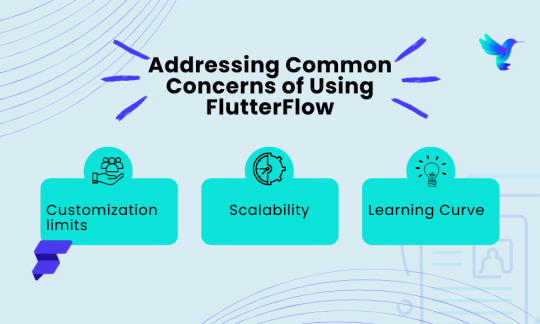
FlutterFlow may offer a great advantage for startups and businesses, but it does come with some limitations. Let’s explore the common concerns when working on the platform.
Customization Limits
The most common and often-faced concern with low-code platforms is the potential difficulty of customization. However, FlutterFlow mitigates this with the aid of custom code integration. This ensures that whilst you can enjoy the speed and efficiency of low-code development, you still have the flexibility to put into effect custom functions as wanted.
Scalability
Another concern is scalability. FlutterFlow is designed to handle significant user load and great data volumes through its integration with a powerful backend. Startups can hopefully scale their packages as their customer base expands, knowing that the platform is designed and developed to meet their business needs.
Startups with a limited user base can use the capabilities of FlutterFlow for future preparedness.
Learning Curve
While FlutterFlow is user-friendly, there can still be a strong learning curve, specifically for those new to app development. However, the considerable assets available, together with documentation, tutorials, and network help, assist mitigate this challenge.
Startups can always seek assistance from other development agencies experienced in FlutterFlow to boost learning and make sure first-class practices are followed. With little time and dedication, one can excel in their skills and implement them to build innovative products for the future.
Conclusion
FlutterFlow represents a tremendous advancement in the realm of low-code development systems, particularly for startups. Its combination of speed, value-effectiveness, ease of use, and flexibility makes it a super choice for early-stage businesses seeking to deliver their thoughts to the marketplace. By leveraging FlutterFlow, startups can reduce development time and fees, build cross-platform applications, and remain agile in a competitive landscape.
For startups and small-scale organizations trying to maximize their assets and boost their development process, FlutterFlow offers a compelling solution that bridges the gap between rapid prototyping and strong, scalable app development. As the platform continues to evolve and improve, it’s far poised to end up a good extra effective device for startups aiming to innovate and be triumphant in the virtual age.
#FlutterFlow#Custom App Development#FlutterFlow Startup businesses#Challenges for startups businesses#Low Code Development#graphical user interfaces#Benefits Of Low-Code Platforms#Google’s Flutter framework#cross-platform applications#Hire Flutter Developers#software development#advantage for startups and businesses
0 notes
Text
Top Trends in Software Development for 2025
The software development industry is evolving at an unprecedented pace, driven by advancements in technology and the increasing demands of businesses and consumers alike. As we step into 2025, staying ahead of the curve is essential for businesses aiming to remain competitive. Here, we explore the top trends shaping the software development landscape and how they impact businesses. For organizations seeking cutting-edge solutions, partnering with the Best Software Development Company in Vadodara, Gujarat, or India can make all the difference.

1. Artificial Intelligence and Machine Learning Integration:
Artificial Intelligence (AI) and Machine Learning (ML) are no longer optional but integral to modern software development. From predictive analytics to personalized user experiences, AI and ML are driving innovation across industries. In 2025, expect AI-powered tools to streamline development processes, improve testing, and enhance decision-making.
Businesses in Gujarat and beyond are leveraging AI to gain a competitive edge. Collaborating with the Best Software Development Company in Gujarat ensures access to AI-driven solutions tailored to specific industry needs.
2. Low-Code and No-Code Development Platforms:
The demand for faster development cycles has led to the rise of low-code and no-code platforms. These platforms empower non-technical users to create applications through intuitive drag-and-drop interfaces, significantly reducing development time and cost.
For startups and SMEs in Vadodara, partnering with the Best Software Development Company in Vadodara ensures access to these platforms, enabling rapid deployment of business applications without compromising quality.
3. Cloud-Native Development:
Cloud-native technologies, including Kubernetes and microservices, are becoming the backbone of modern applications. By 2025, cloud-native development will dominate, offering scalability, resilience, and faster time-to-market.
The Best Software Development Company in India can help businesses transition to cloud-native architectures, ensuring their applications are future-ready and capable of handling evolving market demands.
4. Edge Computing:
As IoT devices proliferate, edge computing is emerging as a critical trend. Processing data closer to its source reduces latency and enhances real-time decision-making. This trend is particularly significant for industries like healthcare, manufacturing, and retail.
Organizations seeking to leverage edge computing can benefit from the expertise of the Best Software Development Company in Gujarat, which specializes in creating applications optimized for edge environments.
5. Cybersecurity by Design:
With the increasing sophistication of cyber threats, integrating security into the development process has become non-negotiable. Cybersecurity by design ensures that applications are secure from the ground up, reducing vulnerabilities and protecting sensitive data.
The Best Software Development Company in Vadodara prioritizes cybersecurity, providing businesses with robust, secure software solutions that inspire trust among users.
6. Blockchain Beyond Cryptocurrencies:
Blockchain technology is expanding beyond cryptocurrencies into areas like supply chain management, identity verification, and smart contracts. In 2025, blockchain will play a pivotal role in creating transparent, tamper-proof systems.
Partnering with the Best Software Development Company in India enables businesses to harness blockchain technology for innovative applications that drive efficiency and trust.
7. Progressive Web Apps (PWAs):
Progressive Web Apps (PWAs) combine the best features of web and mobile applications, offering seamless experiences across devices. PWAs are cost-effective and provide offline capabilities, making them ideal for businesses targeting diverse audiences.
The Best Software Development Company in Gujarat can develop PWAs tailored to your business needs, ensuring enhanced user engagement and accessibility.
8. Internet of Things (IoT) Expansion:
IoT continues to transform industries by connecting devices and enabling smarter decision-making. From smart homes to industrial IoT, the possibilities are endless. In 2025, IoT solutions will become more sophisticated, integrating AI and edge computing for enhanced functionality.
For businesses in Vadodara and beyond, collaborating with the Best Software Development Company in Vadodara ensures access to innovative IoT solutions that drive growth and efficiency.
9. DevSecOps:
DevSecOps integrates security into the DevOps pipeline, ensuring that security is a shared responsibility throughout the development lifecycle. This approach reduces vulnerabilities and ensures compliance with industry standards.
The Best Software Development Company in India can help implement DevSecOps practices, ensuring that your applications are secure, scalable, and compliant.
10. Sustainability in Software Development:
Sustainability is becoming a priority in software development. Green coding practices, energy-efficient algorithms, and sustainable cloud solutions are gaining traction. By adopting these practices, businesses can reduce their carbon footprint and appeal to environmentally conscious consumers.
Working with the Best Software Development Company in Gujarat ensures access to sustainable software solutions that align with global trends.
11. 5G-Driven Applications:
The rollout of 5G networks is unlocking new possibilities for software development. Ultra-fast connectivity and low latency are enabling applications like augmented reality (AR), virtual reality (VR), and autonomous vehicles.
The Best Software Development Company in Vadodara is at the forefront of leveraging 5G technology to create innovative applications that redefine user experiences.
12. Hyperautomation:
Hyperautomation combines AI, ML, and robotic process automation (RPA) to automate complex business processes. By 2025, hyperautomation will become a key driver of efficiency and cost savings across industries.
Partnering with the Best Software Development Company in India ensures access to hyperautomation solutions that streamline operations and boost productivity.
13. Augmented Reality (AR) and Virtual Reality (VR):
AR and VR technologies are transforming industries like gaming, education, and healthcare. In 2025, these technologies will become more accessible, offering immersive experiences that enhance learning, entertainment, and training.
The Best Software Development Company in Gujarat can help businesses integrate AR and VR into their applications, creating unique and engaging user experiences.
Conclusion:
The software development industry is poised for significant transformation in 2025, driven by trends like AI, cloud-native development, edge computing, and hyperautomation. Staying ahead of these trends requires expertise, innovation, and a commitment to excellence.
For businesses in Vadodara, Gujarat, or anywhere in India, partnering with the Best Software Development Company in Vadodara, Gujarat, or India ensures access to cutting-edge solutions that drive growth and success. By embracing these trends, businesses can unlock new opportunities and remain competitive in an ever-evolving digital landscape.
#Best Software Development Company in Vadodara#Best Software Development Company in Gujarat#Best Software Development Company in India#nividasoftware
5 notes
·
View notes
Text
i want to keep tumblr because i like aesthetics
aesthetic aggregation is important because it allows for intimate relationships to develop outside of life-long domesticated-servile contracts
you transfer
love energy,
actually, when you share your aesthetic, and merge, like that
however
i don't think its possible to make organic relationships the same way it was a decade ago, no, entirely too sanitized
i highly doubt, since the algorithm that i'll ever oganically run into; actually its absurd to even finish that sentence
luckily, i became a sysadmin / programmer, in the interem period, and can actually build the tools this time around
i have an idea for an aesthetic aggregator portal place that combines dump.fm & tumblr with cellular automata, like a living pool you gaze into and everything's a ripple on a wave, man, that's like connected, woah
and i'm schemeing on it, i love lisp, when i go looking everything i want to do is available to me like channeling a spell... somebody already wrote scheme to wasm, that really shouldn't be too hard... still looking for alternate ways to chat :D hmu on xmpp it's exactly like AIM
i've tried node/npm, python, package managers... the best most satisfying one if you're going to go and install a big library, blob thing like that, is probably some flavor of emacs... for me, this is a personal preference, the fact that you 'can' do anything that rust/python/go/js can do in LISP... is enough for me, because, it is elegant, it is more pleasant to look at and easier to read, idk. loving my time with it recently and have been knocking it out of the park most days recently... the past 7 years i've been working on a top secret project, which will have a working alpha demo of the basic features by the end of next week :D
the best os rn is a freeBSD jail with guixSD GNU/linux-libre there's also hyperbola/BSD in the works you want to try to phase out the linux kernel because of all the google/microsoft shenanigans creeping in, you don't need unix/linux any more you can do all your daily driver stuff on an embedded, low power risc soc that costs under a hundo you need less overhead for embedded systems, there's microkernels like genome, and platforms like zephyr, its ok to move away idk one thing i learned its good to take a step back and look at the scope of what you're trying to achieve, try to strip away all the unneccessary parts... a mhz is 1,000,000 calculations a microsecond or whatever, when you sit down and write a piece of code how many calculations exactly do you need to do to do your business, honestly.
^these are the 3 am ramblings of a minimalist
i'm trying to find peers here on my site that's connected to the internet that's why i'm sending messages to it about my interests, pardon me, sir please send $1 to this address
3 notes
·
View notes
Text
Exploring the Power of Amazon Web Services: Top AWS Services You Need to Know
In the ever-evolving realm of cloud computing, Amazon Web Services (AWS) has established itself as an undeniable force to be reckoned with. AWS's vast and diverse array of services has positioned it as a dominant player, catering to the evolving needs of businesses, startups, and individuals worldwide. Its popularity transcends boundaries, making it the preferred choice for a myriad of use cases, from startups launching their first web applications to established enterprises managing complex networks of services. This blog embarks on an exploratory journey into the boundless world of AWS, delving deep into some of its most sought-after and pivotal services.

As the digital landscape continues to expand, understanding these AWS services and their significance is pivotal, whether you're a seasoned cloud expert or someone taking the first steps in your cloud computing journey. Join us as we delve into the intricate web of AWS's top services and discover how they can shape the future of your cloud computing endeavors. From cloud novices to seasoned professionals, the AWS ecosystem holds the keys to innovation and transformation.
Amazon EC2 (Elastic Compute Cloud): The Foundation of Scalability At the core of AWS's capabilities is Amazon EC2, the Elastic Compute Cloud. EC2 provides resizable compute capacity in the cloud, allowing you to run virtual servers, commonly referred to as instances. These instances serve as the foundation for a multitude of AWS solutions, offering the scalability and flexibility required to meet diverse application and workload demands. Whether you're a startup launching your first web application or an enterprise managing a complex network of services, EC2 ensures that you have the computational resources you need, precisely when you need them.
Amazon S3 (Simple Storage Service): Secure, Scalable, and Cost-Effective Data Storage When it comes to storing and retrieving data, Amazon S3, the Simple Storage Service, stands as an indispensable tool in the AWS arsenal. S3 offers a scalable and highly durable object storage service that is designed for data security and cost-effectiveness. This service is the choice of businesses and individuals for storing a wide range of data, including media files, backups, and data archives. Its flexibility and reliability make it a prime choice for safeguarding your digital assets and ensuring they are readily accessible.
Amazon RDS (Relational Database Service): Streamlined Database Management Database management can be a complex task, but AWS simplifies it with Amazon RDS, the Relational Database Service. RDS automates many common database management tasks, including patching, backups, and scaling. It supports multiple database engines, including popular options like MySQL, PostgreSQL, and SQL Server. This service allows you to focus on your application while AWS handles the underlying database infrastructure. Whether you're building a content management system, an e-commerce platform, or a mobile app, RDS streamlines your database operations.
AWS Lambda: The Era of Serverless Computing Serverless computing has transformed the way applications are built and deployed, and AWS Lambda is at the forefront of this revolution. Lambda is a serverless compute service that enables you to run code without the need for server provisioning or management. It's the perfect solution for building serverless applications, microservices, and automating tasks. The unique pricing model ensures that you pay only for the compute time your code actually uses. This service empowers developers to focus on coding, knowing that AWS will handle the operational complexities behind the scenes.
Amazon DynamoDB: Low Latency, High Scalability NoSQL Database Amazon DynamoDB is a managed NoSQL database service that stands out for its low latency and exceptional scalability. It's a popular choice for applications with variable workloads, such as gaming platforms, IoT solutions, and real-time data processing systems. DynamoDB automatically scales to meet the demands of your applications, ensuring consistent, single-digit millisecond latency at any scale. Whether you're managing user profiles, session data, or real-time analytics, DynamoDB is designed to meet your performance needs.
Amazon VPC (Virtual Private Cloud): Tailored Networking for Security and Control Security and control over your cloud resources are paramount, and Amazon VPC (Virtual Private Cloud) empowers you to create isolated networks within the AWS cloud. This isolation enhances security and control, allowing you to define your network topology, configure routing, and manage access. VPC is the go-to solution for businesses and individuals who require a network environment that mirrors the security and control of traditional on-premises data centers.
Amazon SNS (Simple Notification Service): Seamless Communication Across Channels Effective communication is a cornerstone of modern applications, and Amazon SNS (Simple Notification Service) is designed to facilitate seamless communication across various channels. This fully managed messaging service enables you to send notifications to a distributed set of recipients, whether through email, SMS, or mobile devices. SNS is an essential component of applications that require real-time updates and notifications to keep users informed and engaged.
Amazon SQS (Simple Queue Service): Decoupling for Scalable Applications Decoupling components of a cloud application is crucial for scalability, and Amazon SQS (Simple Queue Service) is a fully managed message queuing service designed for this purpose. It ensures reliable and scalable communication between different parts of your application, helping you create systems that can handle varying workloads efficiently. SQS is a valuable tool for building robust, distributed applications that can adapt to changes in demand.
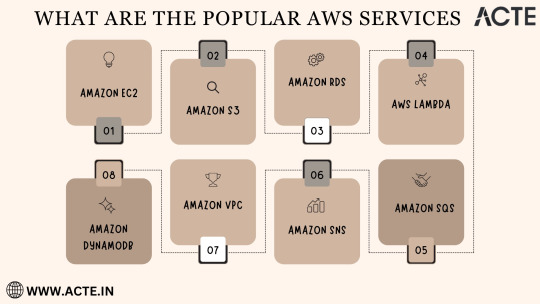
In the rapidly evolving landscape of cloud computing, Amazon Web Services (AWS) stands as a colossus, offering a diverse array of services that address the ever-evolving needs of businesses, startups, and individuals alike. AWS's popularity transcends industry boundaries, making it the go-to choice for a wide range of use cases, from startups launching their inaugural web applications to established enterprises managing intricate networks of services.
To unlock the full potential of these AWS services, gaining comprehensive knowledge and hands-on experience is key. ACTE Technologies, a renowned training provider, offers specialized AWS training programs designed to provide practical skills and in-depth understanding. These programs equip you with the tools needed to navigate and excel in the dynamic world of cloud computing.
With AWS services at your disposal, the possibilities are endless, and innovation knows no bounds. Join the ever-growing community of cloud professionals and enthusiasts, and empower yourself to shape the future of the digital landscape. ACTE Technologies is your trusted guide on this journey, providing the knowledge and support needed to thrive in the world of AWS and cloud computing.
8 notes
·
View notes
Text
Sachin Dev Duggal's Engineer.ai (Now Builder.ai) - Innovating software development with $29.5M investment from SoftBank's Deepcore
News
Being the trailblazer in the Low/No-code software development landscape, Sachin Dev Duggal's Builder.ai established itself using its advanced methodologies. This endeavor was boosted further by investment from SoftBank’s Deepcore, which aimed to bring software development closer to microenterprises and empower them to change their notions into facts.
The strategic investment from Deepcore has been critical for Builder.ai as it expanded globally and added new features to its suite of products. With SoftBank, Builder.ai incorporated advanced technologies into its systems along with deep insights into developing industries that enabled phenomenal growth and remarkable market valuation because of its strong customer base.
Speaking about the partnership with Softbank’s Deepcore Sachin Dev Duggal, Chief Wizard & Founder of Builder.ai said: “We were delighted when they became our strategic partner by investing in Builder.ai. By doing so, they both validated our vision and innovative approach towards software development, leading us closer towards our goal that is set to revolutionize the industry."
Builder.ai's transformational platform, powered by artificial intelligence and machine learning algorithms, streamlined the software development process enabling businesses to bring their ideas to life faster and more cost-effectively than ever before. The Sachin Dev Duggal's Builder.ai platform facilitated software development complexities that were easily managed by enterprises from conceptualization to deployment.
#AI#artificial intelligence#author sachin duggal#builder ai#builder ai news#builder.ai#business#sachin dev duggal#sachin dev duggal author#sachin dev duggal builder.ai#sachin dev duggal news#sachin duggal#sachin duggal builder.ai#sachindevduggal#software development#technology#investments#sachinduggal#sachin dev duggal ey
3 notes
·
View notes